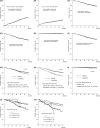Transoral surgery for superficial head and neck cancer: National Multi-Center Survey in Japan
- PMID: 33991076
- PMCID: PMC8209601
- DOI: 10.1002/cam4.3927
Transoral surgery for superficial head and neck cancer: National Multi-Center Survey in Japan
Abstract
Head and neck cancers, especially in hypopharynx and oropharynx, are often detected at advanced stage with poor prognosis. Narrow band imaging enables detection of superficial cancers and transoral surgery is performed with curative intent. However, pathological evaluation and real-world safety and clinical outcomes have not been clearly understood. The aim of this nationwide multicenter study was to investigate the safety and efficacy of transoral surgery for superficial head and neck cancer. We collected the patients with superficial head and neck squamous cell carcinoma who were treated by transoral surgery from 27 hospitals in Japan. Central pathology review was undertaken on all of the resected specimens. The primary objective was effectiveness of transoral surgery, and the secondary objective was safety including incidence and severity of adverse events. Among the 568 patients, a total of 662 lesions were primarily treated by 575 sessions of transoral surgery. The median tumor diameter was 12 mm (range 1-75) endoscopically. Among the lesions, 57.4% were diagnosed as squamous cell carcinoma in situ. The median procedure time was 48 minutes (range 2-357). Adverse events occurred in 12.7%. Life-threatening complications occurred in 0.5%, but there were no treatment-related deaths. During a median follow-up period of 46.1 months (range 1-113), the 3-year overall survival rate, relapse-free survival rate, cause-specific survival rate, and larynx-preservation survival rate were 88.1%, 84.4%, 99.6%, and 87.5%, respectively. Transoral surgery for superficial head and neck cancer offers effective minimally invasive treatment. Clinical trials registry number: UMIN000008276.
Keywords: head and neck cancer; larynx preservation; pharyngeal cancer; superficial cancer; transoral surgery.
© 2021 The Authors. Cancer Medicine published by John Wiley & Sons Ltd.
Conflict of interest statement
Professor Manabu Muto received a joint research fund between Kyoto University and Olympus Corporation out of this study. Dr. Ryuichi Hayashi received a grant from the Japan Agency for Medical Research and Development (Grant No. 19ck0106510h0001). Other authors have not declared a specific grant for this study from any funding agency in the public, commercial, or not‐for‐profit sectors.
Figures


Similar articles
-
Treatment outcomes of transoral robotic and non-robotic surgeries to treat oropharyngeal, hypopharyngeal, and supraglottic squamous cell carcinoma: A multi-center retrospective observational study in Japan.Auris Nasus Larynx. 2021 Jun;48(3):502-510. doi: 10.1016/j.anl.2021.01.024. Epub 2021 Feb 22. Auris Nasus Larynx. 2021. PMID: 33632582
-
Transoral surgery for laryngo-pharyngeal cancer - The paradigm shift of the head and cancer treatment.Auris Nasus Larynx. 2016 Feb;43(1):21-32. doi: 10.1016/j.anl.2015.06.013. Epub 2015 Aug 19. Auris Nasus Larynx. 2016. PMID: 26298233 Review.
-
Transoral laser microsurgery for locally advanced (T3-T4a) supraglottic squamous cell carcinoma: Sixteen years of experience.Head Neck. 2016 Jul;38(7):1050-7. doi: 10.1002/hed.24408. Epub 2016 Feb 13. Head Neck. 2016. PMID: 26872432
-
Long-term outcome of transoral organ-preserving pharyngeal endoscopic resection for superficial pharyngeal cancer.Gastrointest Endosc. 2011 Sep;74(3):477-84. doi: 10.1016/j.gie.2011.04.027. Epub 2011 Jun 25. Gastrointest Endosc. 2011. PMID: 21704994
-
Salvage surgery for advanced stage head and neck squamous cell carcinoma following radiotherapy or chemoradiation.Eur Arch Otorhinolaryngol. 2019 Mar;276(3):647-655. doi: 10.1007/s00405-019-05292-0. Epub 2019 Jan 23. Eur Arch Otorhinolaryngol. 2019. PMID: 30673847
Cited by
-
Endoscopic submucosal dissection for hypopharyngeal cancer simultaneous with immunotherapy for renal cell carcinoma.DEN Open. 2024 Sep 23;5(1):e70009. doi: 10.1002/deo2.70009. eCollection 2025 Apr. DEN Open. 2024. PMID: 39315120 Free PMC article.
-
Alcohol consumption, multiple Lugol-voiding lesions, and field cancerization.DEN Open. 2023 Jul 3;4(1):e261. doi: 10.1002/deo2.261. eCollection 2024 Apr. DEN Open. 2023. PMID: 37409321 Free PMC article. Review.
-
Quantification of oxygen consumption in head and neck cancer using fluorescent sensor foil technology.Front Oncol. 2024 Feb 8;14:1002798. doi: 10.3389/fonc.2024.1002798. eCollection 2024. Front Oncol. 2024. PMID: 38390268 Free PMC article.
-
Efficacy and safety of the water pressure method for endoscopic submucosal dissection in superficial pharyngeal cancer.Endosc Int Open. 2024 Apr 26;12(4):E621-E628. doi: 10.1055/a-2284-9184. eCollection 2024 Apr. Endosc Int Open. 2024. PMID: 38681148 Free PMC article.
-
The safety and efficacy of endoscopic submucosal dissection for superficial pharyngeal squamous cell neoplasms: a single-center study in China.Surg Endosc. 2025 Jun;39(6):3600-3609. doi: 10.1007/s00464-025-11636-1. Epub 2025 Apr 21. Surg Endosc. 2025. PMID: 40259092
References
-
- Bray F, Ferlay J, Soerjomataram I, Siegel RL, Torre LA, Jemal A. Global cancer statistics 2018: GLOBOCAN estimates of incidence and mortality worldwide for 36 cancers in 185 countries. CA Cancer J Clin. 2018;68:394‐424. - PubMed
-
- Hoffman HT, Karnell LH, Shah JP, et al. Hypopharyngeal cancer patient care evaluation. Laryngoscope. 1997;107:1005‐1017. - PubMed
-
- Bova R, Goh R, Poulson M, Coman WB. Total pharyngolaryngectomy for squamous cell carcinoma of the hypopharynx: a review. Laryngoscope. 2005;115:864‐869. - PubMed
-
- Chao KS, Deasy JO, Markman J, et al. A prospective study of salivary function sparing in patients with head‐and‐neck cancers receiving intensity‐modulated or three‐dimensional radiation therapy: initial results. Int J Radiat Oncol Biol Phys. 2001;49:907‐916. - PubMed
Publication types
MeSH terms
Associated data
- Actions
LinkOut - more resources
Full Text Sources
Other Literature Sources
Medical

